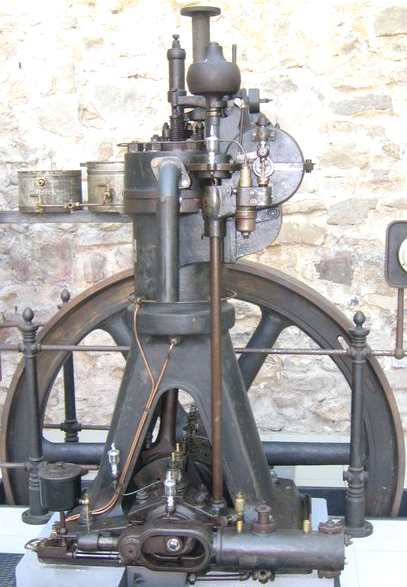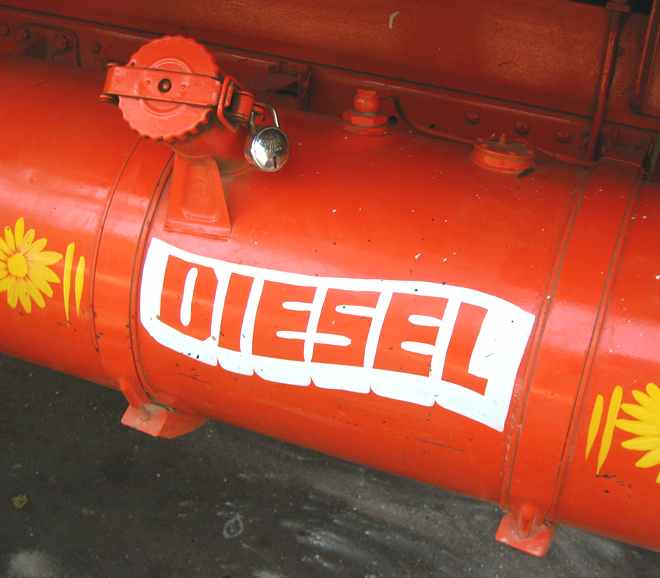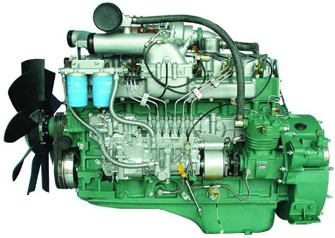|
Diesel or diesel fuel
oil, is a specific fractional distillate of fuel oil (mostly petroleum) that is used as fuel in a diesel engine invented by German engineer Rudolf Diesel. The term typically refers to fuel that has been processed from petroleum, but increasingly, alternatives such as biodiesel or biomass to liquid (BTL) or gas to liquid (GTL) diesel that are not derived from petroleum are being developed and adopted.
Although Rudolph Diesel's name has become attached to the compression combustion engine and the fuel that it consumes, he was not first to invent the diesel engine. His patent was filed in 1893. However Herbert Akroyd Stuart, built the first compression-ignition oil engine in Bletchley, England, in 1891. He leased the rights to Richard Hornsby & Sons in July 1892, five years before Diesel's prototype was
built.

1906
single cylinder diesel engine
Petroleum diesel
Diesel is produced from petroleum, and is sometimes called petrodiesel when there is a need to distinguish it from diesel obtained from other sources such as biodiesel. It is a hydrocarbon mixture, obtained in the fractional distillation of crude oil between 200 °C and 350 °C at atmospheric pressure.
The density of diesel is about 850 grams per liter whereas gasoline (British English: petrol) has a density of about 720 g/L, about 15% less. When burnt, diesel typically releases about 40.9 megajoules (MJ) per liter, whereas gasoline releases 34.8 MJ/L, about 15% less. Diesel is generally simpler to refine than gasoline and often costs less (although price fluctuations sometimes mean that the inverse is true; for example, the cost of diesel traditionally rises during colder months as demand for heating oil, which is refined much the same way, rises). Also, due to its high level of pollutants, diesel fuel must undergo additional filtration which contributes to a sometimes higher cost. In many parts of the
United States and throughout the whole of the UK, diesel is higher priced than
gasoline. Reasons for higher priced diesel include the shutdown of some refineries in the Gulf of Mexico, and the switch to ultra-low sulfur diesel (ULSD), which causes infrastructural
complications.
Diesel-powered cars generally have a better fuel economy than equivalent gasoline engines and produce less greenhouse gas pollution. This greater fuel economy is due to the higher energy per-liter content of diesel fuel and also to the intrinsic efficiency of the diesel engine. While diesel's 15% higher density results in 15% higher greenhouse gas emissions per liter compared to
gasoline, the 20–40% better fuel economy achieved by modern diesel-engined automobiles offsets the higher-per-liter emissions of greenhouse gases, resulting in significantly lower carbon dioxide emissions per
kilometer.
On the other hand, diesel fuel often contains higher quantities of sulfur.
European emission standards and preferential taxation have forced oil refineries to dramatically reduce the level of sulfur in diesel fuels. In contrast, the United States has long had "dirtier" diesel, although more stringent emission standards have been adopted with the transition to ULSD starting in 2006 and becoming mandatory on June 1, 2010 (see also diesel exhaust). U.S. diesel fuel typically also has a lower cetane number (a measure of ignition quality) than European diesel, resulting in worse cold weather performance and some increase in emissions. High levels of sulfur in diesel are harmful for the environment because they prevent the use of catalytic diesel particulate filters to control diesel particulate emissions, as well as more advanced technologies, such as nitrogen oxide (NOx) adsorbers (still under development), to reduce emissions. However, the process for lowering sulfur also reduces the lubricity of the fuel, meaning that additives must be put into the fuel to help lubricate engines. Biodiesel is an effective lubricant.
The U.S. annual consumption of diesel fuel in 2006 was about 190 billion liters (50 billion
gallons).
Chemical composition
Diesel is immiscible with water
Petroleum-derived diesel is composed of about 75% saturated hydrocarbons (primarily paraffins including n, iso, and cycloparaffins), and 25% aromatic hydrocarbons (including naphthalenes and
alkylbenzenes). The average chemical formula for common diesel fuel is C12H23, ranging from approx. C10H20 to C15H28
Algae, microbes, and water
There has been much discussion and misinformation about algae in diesel fuel[citation needed]. Algae require sunlight to live and grow. As there is no sunlight in a closed fuel tank, no algae can survive there. However, some microbes can survive there, and can feed on the diesel fuel.
These microbes form a slimy colony that lives at the fuel/water interface. They grow quite rapidly in warmer temperatures. They can even grow in cold weather when fuel tank heaters are installed. Parts of the colony can break off and clog the fuel lines and fuel filters.
It is possible to either kill this growth with a biocide treatment, or eliminate the water, a necessary component of microbial life. There are a number of biocides on the market, which must be handled very carefully. If a biocide is used, it must be added every time a tank is refilled until the problem is fully resolved.
Biocides attack the cell wall of microbes resulting in lysis, the death of a cell by bursting. The dead cells then gather on the bottom of the fuel tanks and form a sludge, filter clogging will continue after biocide treatment until the sludge has abated.
Given the right conditions microbes will repopulate the tanks and re-treatment with biocides will then be necessary. With repetitive biocide treatments microbes can then form resistance to a particular brand. Trying another brand may resolve this.
Synthetic diesel
Wood, hemp, straw, corn, garbage, food scraps, and sewage-sludge may be dried and gasified to synthesis gas. After purification the Fischer-Tropsch process is used to produce synthetic diesel.[7] This means that synthetic diesel oil may be one route to biomass based diesel oil. Such processes are often called Biomass-To-Liquids or BTL.
Synthetic diesel may also be produced out of natural gas in the Gas-to-liquid (GTL) process or out of coal in the
Coal-to-liquid (CTL) process. Such synthetic diesel has 30% less particulate emissions than conventional diesel (US-
California).
Biodiesel
Biodiesel can be obtained from vegetable oil (vegidiesel / vegifuel), or animal fats (bio-lipids, using transesterification). Biodiesel is a non-fossil fuel alternative to petrodiesel. It can also be mixed with petrodiesel in any amount in modern engines, though when first using it, the solvent properties of the fuel tend to dissolve accumulated deposits and can clog fuel filters. Biodiesel has a higher gel point than petrodiesel, but is comparable to diesel. This can be overcome by using a biodiesel/petrodiesel blend, or by installing a fuel heater, but this is only necessary during the colder months. There have been reports that a diesel-biodiesel mix results in lower emissions than either can achieve alone.[citation needed] A small percentage of biodiesel can be used as an additive in low-sulfur formulations of diesel to increase the lubricity lost when the sulfur is removed.
Biodiesel can be produced using kits. Certain kits allow for processing of used vegetable oil that can be run through any conventional diesel motor with little modifications. The minor modification needed is the replacement of fuel lines from the intake and motor. This is because biodiesel is an effective solvent and will dissolve rubber over time. Synthetic hoses prevent this.
Chemically, most biodiesel consists of alkyl (usually methyl) esters instead of the alkanes and aromatic hydrocarbons of petroleum derived diesel. However, biodiesel has combustion properties very similar to petrodiesel, including combustion energy and cetane ratings. Paraffin biodiesel also exists. Due to the purity of the source, it has a higher quality than petrodiesel.
Ethanol can be added to petroleum diesel fuel in amounts up to 15% along with additives to keep the ethanol
emulsified. However, the cetane rating and lubricity of the fuel are both reduced and must be corrected with additives.
ASTM International has developed D6751 as the specification standard for 100% biodiesel, which is used for blending with petroleum diesel. For example, B20 is 20% biodiesel (ASTM D6751) and 80% petroleum diesel (ASTM D975).

An external diesel fuel tank on a truck in
India
Applications
Internal combustion engines
Diesel engines are a type of internal combustion engine. Rudolf Diesel originally designed the diesel engine to use vegetable oils as a fuel in order to help support agrarian society and to enable independent craftsmen and artisans to compete with large industry.[10][11] Diesel engines are used in cars, trucks, motorcycles, boats and locomotives.
First Diesel Aircraft
The first diesel powered flight of a fixed wing aircraft took place the evening of September 18, 1928, at the Packard Motor Company proving grounds, Utica, Michigan with Captain Lionel M. Woolson and Walter Lees at the controls (the first "offical" test flight was taken the next morning). The engine was designed for Packard by Woolson and the aircraft was a Stinson SM1B, X7654. Later that year Charles Lindbergh flew the same aircraft. In 1929 it was flown 621 miles non-stop from Detroit to Langley, Virginia (near Washington, D.C.). This aircraft is presetly owned by Greg Herrick and resides in the Golden Wings Flying Museum near Minneapolis, Minnestoa. In 1931, Walter Lees and Fredrick Brossy set the nonstop flight record flying a Bellanca powered by a Packard diesel for 84h 32m. The Hindenburg was powered by four 16 cylinder diesel
engines, each with approximately 1200 horsepower available in bursts, and 850 horsepower available for cruising. Modern diesel engines for propellor-driven aircraft are manufactured by Thielert Aircraft Engines and SMA. These engines are able to run on Jet A fuel, which is similar in composition to automotive diesel and cheaper and more plentiful than the 100 octane low-lead gasoline (avgas) used by the majority of the piston-engine aircraft fleet.
The very first diesel-engine automobile trip was completed on January 6, 1930. The trip was from Indianapolis to New York City, a distance of nearly 800 miles (1300 km). This feat helped to prove the usefulness of the internal combustion engine.
Primarily diesel fuel is used in high torque engines such as those found in tractors, construction equipment, trucks and large emergency generators. Diesel engines have a higher compression than gasoline engines, resulting in greater power and torque at low engine speeds.
Diesel fuel is however not as broadly accepted in climates that experienced prolonged temperatures below -17°C (0°F) as this is the temperature at which diesel fuel gels, and it begins to cloud at -6°C (20°F). For use in colder climates, anti-gel agents are required.
Automobile racing
In 1931, Dave Evans drove his Cummins Diesel Special to a nonstop finish in the Indianapolis 500, the first time a car had completed the race without a pit stop. That car and a later Cummins Diesel Special are on display at the Indianapolis Motor Speedway Hall of Fame
Museum.
In the late 1970s Mercedes-Benz at Nardo drove a C111-III with a 5 cylinder diesel engine to several new records, including driving an average of 314 km/h (195 mph) for 12 hours and hitting a top speed of 325 km/h (201 mph).
With turbocharged diesel cars getting stronger in the 1990s, they were entered in touring car racing, and BMW even won the 24 Hours Nürburgring in 1998 with a 320d. After winning the 12 Hours of Sebring in 2006 with their diesel-powered R10 LMP, Audi won the 24 Hours of Le Mans, too. This is the first time a diesel-fueled vehicle has won at Le Mans against cars powered with regular fuel or other alternative fuel like methanol or bio-ethanol. Competitors like Porsche predicted this victory for Audi as current FIA and ACO regulations are seen as pro-diesel. French automaker Peugeot entered the diesel powered Peugeot 908 LMP in the 2007 24 Hours of Le Mans in response to the success of the Audi R10.
In an effort to further demonstrate the potential of diesel power, California-based Gale Banks Engineering designed, built and raced a Cummins-powered pickup at the Bonneville Salt Flats in October 2002. The truck set a top speed of 355 km/h (222 mph) and became the world’s fastest pickup, and almost equally notable, the truck drove to the race towing its own support trailer.
On 23 August 2006, the British-based earthmoving machine manufacturer JCB raced the specially designed JCB Dieselmax car at 563.4 km/h (350.1 mph). The driver was Andy Green. The car was powered by two modified JCB 444 diesel engines.
Other uses
Bad quality (high sulfur) diesel fuel has been used as a palladium extraction agent for the liquid-liquid extraction of this metal from nitric acid mixtures. This has been proposed as a means of separating the fission product palladium from PUREX raffinate which comes from used nuclear fuel. In this solvent extraction system the hydrocarbons of the diesel act as the diluent while the dialkyl sulfides act as the extractant. This extraction operates by a solvation mechanism. So far neither a pilot plant or full scale plant has been constructed to recover palladium, rhodium or ruthenium from nuclear wastes created by the use of nuclear
fuel.
Taxation
Diesel fuel is very similar to heating oil which is used in central heating. In Europe, the United States, and Canada, taxes on diesel fuel are higher than on heating oil due to the fuel tax, and in those areas, heating oil is marked with fuel dyes and trace chemicals to prevent and detect tax fraud. Similarly, "untaxed" diesel (sometimes called "off road diesel") is available in the United States, which is available for use primarily in agricultural applications such as fuel for tractors, recreational and utility vehicles or other non-commercial vehicles that do not use public roads. Additionally, this fuel may have sulphur levels that exceed the limits for road use using the newer 2007 standards. This untaxed diesel is dyed red for identification
purposes, and should a person be found to be using this untaxed diesel fuel for a typically taxed purpose (such as "over-the-road", or driving use), the user can be fined US$10,000. In the United Kingdom and the Netherlands it is known as red diesel (or gas oil), and is also used in agricultural vehicles, home heating tanks and refrigeration units on vans/trucks which contain perishable items (e.g. food, medicine). Diesel fuel, or Marked Gas Oil is dyed green in the Republic of Ireland. The term DERV (short for "diesel engined road vehicle") is also used in the UK as a synonym for diesel fuel. In India, taxes on diesel fuel are lower than on gasoline as the majority of the transportation that transports grains and other essential commodities across the country runs on diesel.
Taxes on biodiesel in the United States vary from state to state and in some states (Texas, for example) have no tax on biodiesel and a reduced tax on biodiesel blends equivelent to the amount of biodiesel in the blend, so B20 fuel has 20% less State fuel tax than pure
petrodiesel. Other states, such as North Carolina, tax biodiesel the same as petrodiesel, although they have introduced new incentives to producers and users of all
biofuels.

Six
cylinder marine diesel engine
LINKS
and REFERENCE
-
http://tonto.eia.doe.gov/oog/info/gdu/gasdiesel.asp
-
http://www.eia.doe.gov/bookshelf/brochures/diesel/dieselprices2006.html
-
Emission
Facts: Average Carbon Dioxide Emissions Resulting from Gasoline and
Diesel Fuel. US Environmental Protection Agency (2005).
-
"Diesel
cars set to outsell petrol", BBC News
-
More
Miles To The Gallon. Diesel Technology Forum.
-
Agency
for Toxic Substances and Disease Registry (ATSDR). 1995. Toxicological
profile for fuel oils. Atlanta, GA: U.S. Department of
Health and Human Services, Public Health Service
-
http://www.fas.usda.gov/pecad/highlights/2005/01/btl0104/syntheticdiesel.htm.
http://www.fas.usda.gov/pecad2/highlights/2005/01/btl0104/syntheticdiesel.htm
now
-
SYNTHETIC
DIESEL FUEL.
-
Ethanol
Facts: E diesel. Nebraska Ethanol Board.
-
A
History of the Diesel Engine. Yokaya Biofuels.
-
Rudolf
Diesel. About.com.
-
Indianapolis
Motor Speedway.
-
Torgov,
V.G.; Tatarchuk, V.V.; Druzhinina, I.A.; Korda, T.M. et. al, Atomic
Energy, 1994, 76(6), 442–448. (Translated from Atomnaya
Energiya; 76: No. 6, 478–485 (Jun 1994))
-
United
States Government Printing Office Title
26, § 48.4082-1 Diesel fuel and kerosene; exemption for dyed fuel..
Electronic Code of Federal Regulations (e-CFR). “Diesel
fuel or kerosene satisfies the dyeing requirement of this paragraph
(b) only if the diesel fuel or kerosene contains— (1) The dye
Solvent Red 164 (and no other dye) at a concentration spectrally
equivalent to at least 3.9 pounds of the solid dye standard Solvent
Red 26 per thousand barrels of diesel fuel or kerosene; or (2) Any
dye of a type and in a concentration that has been approved by the
Commissioner.” Cited as 26 CFR 48.4082-1. This regulation
implements 26 U.S.C. § 4082-1.
-
http://www.eere.energy.gov/afdc/progs/ind_state_laws.php/TX/BIOD
-
http://www.eere.energy.gov/afdc/progs/ind_state_laws.php/NC/BIOD

Thirst
for a Challenge

Solar
Red | Solar
Crush | Solar
Cola | Solar
Citrus | Solar
Spice
|



